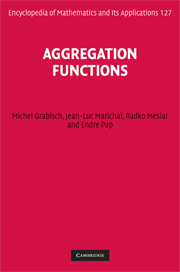Book contents
- Frontmatter
- Contents
- List of figures
- List of tables
- Preface
- 1 Introduction
- 2 Properties for aggregation
- 3 Conjunctive and disjunctive aggregation functions
- 4 Means and averages
- 5 Aggregation functions based on nonadditive integrals
- 6 Construction methods
- 7 Aggregation on specific scale types
- 8 Aggregation on ordinal scales
- 9 Aggregation on bipolar scales
- 10 Behavioral analysis of aggregation functions
- 11 Identification of aggregation functions
- Appendix A Aggregation of infinitely many arguments
- Appendix B Examples and applications
- List of symbols
- References
- Index
11 - Identification of aggregation functions
Published online by Cambridge University Press: 05 March 2013
- Frontmatter
- Contents
- List of figures
- List of tables
- Preface
- 1 Introduction
- 2 Properties for aggregation
- 3 Conjunctive and disjunctive aggregation functions
- 4 Means and averages
- 5 Aggregation functions based on nonadditive integrals
- 6 Construction methods
- 7 Aggregation on specific scale types
- 8 Aggregation on ordinal scales
- 9 Aggregation on bipolar scales
- 10 Behavioral analysis of aggregation functions
- 11 Identification of aggregation functions
- Appendix A Aggregation of infinitely many arguments
- Appendix B Examples and applications
- List of symbols
- References
- Index
Summary
Introduction
The major part of this book is devoted to studying the main classes of aggregation functions, their properties and their construction. A deep understanding of them is necessary to tackle applications, in order to choose - in some sense fixed by the user - the best aggregation function. Yet, it is unlikely that this will suffice to determine in a unique way the aggregation function that best fits a given problem. Properties are merely guidelines to select a family of suitable aggregation functions, e.g., we could deduce that we need a t-norm of the Frank family, an ordered weighted averaging (OWA) function, or a Choquet integral with respect to a capacity exhibiting a positive interaction between criteria 1 and 3. What remains unreachable is the knowledge of the best individual(s) in this family for our problem of interest, that is, the best parameter λ ∈ [0, ∞] of the Frank family, the best weights of the OWA function, and the best capacity for the Choquet integral. By identification, we mean precisely this process of complete determination of the best aggregation function.
The identification can be achieved only if one has at hand a sufficient amount of information, as pairs of input/output data, and some criterion or objective function (e.g., minimize the total squared error). In some cases, the identification is not perfect, in the sense that a unique aggregation function is not produced, but a (usually infinite and convex) set of possible aggregation functions.
Information
- Type
- Chapter
- Information
- Aggregation Functions , pp. 382 - 396Publisher: Cambridge University PressPrint publication year: 2009
